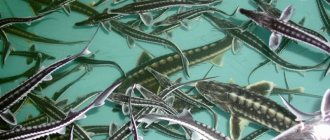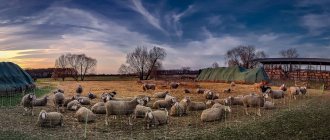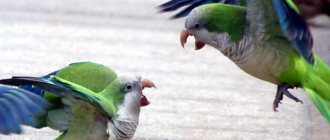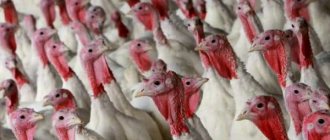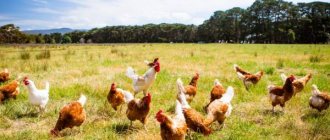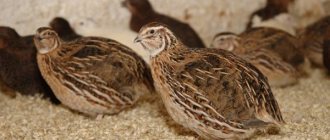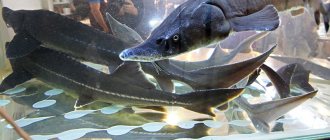Description
Turkeys are colorful, majestic and at the same time, different in size poultry. They love space and freedom . From the first days of life, a hierarchy begins to build in the turkey community.
A bold and cocky male appears and the gluttons are already visible - candidates for fattening for meat. In flocks of male turkeys, the right to fertilize female turkeys belongs to only one turkey, which is at the top of the hierarchy.
Conditions
Raising broiler turkeys at home, as can be seen in the video below, requires a person to comply with the climatic conditions inside the poultry house.
To make the bird comfortable, a beginner should adhere to the following rules:
- The temperature in the room where pets are kept should not drop below zero, and in summer should not rise above 22 degrees. To ensure a comfortable atmosphere, a supply and exhaust hood is installed and the building is insulated.
- The floor in the poultry house is covered with straw or sawdust. Three times a week the bedding is changed to a new one; dampness can cause the bird to catch a cold.
- Females and males are kept together, as a rule, there are up to 8 females per male. If there are several families in the poultry house, then it is necessary to arrange separate rooms with walking areas.
Important! Choose the right food. They actively eat mixtures of grains and bran, fresh greens and wet mash. Additionally, you need to add minerals to the diet: chalk, shell, salt and limestone. It is also important to provide food of animal origin: bone meal, waste meat and dairy products.
Step-by-step raising of turkeys
There are several stages of raising day-old turkey poults at home. The first of these is purchasing chickens. For beginners, it is better to buy a bird that has already grown up; it is already prepared for the diet of adults and quickly gains weight.
Previously acquired young animals can be used to replenish the livestock.
It is necessary to collect the eggs and place them under the laying hen or put them in an incubator. In just 28 days, turkey poults will appear. In the first few days, they must be kept in a brooder, where a certain temperature regime is constantly maintained. The young animals are fed with chopped fresh grass mixed with a boiled egg.
Gradually, the growing young animals are transferred to an adult diet, giving crushed grain and mash. Already from 4 months of life, turkey chicks are actively gaining weight and after about a year they can be sent for slaughter. Males are sent for slaughter 5 years after hatching or if they are found to have serious defects.
Methods of raising turkeys
Beginning poultry farmers can raise turkeys at home either on the run or in cages. Both of these methods have their pros and cons.
Keeping poultry on the range is more profitable in terms of feed. The bird can eat fresh greens and insects on its own, so you can give it additional food three times a day. But with this diet, turkeys slowly gain weight.
The poultry house will have to be insulated and additional heaters installed for the winter period.
It is better to raise turkeys for meat at home in cages. The bird is kept in a cage around the clock, only for a while it can be released for walking. This method is expensive, because more feed is required, but weight is gained at an accelerated pace.
Difficulties
Raising day-old turkeys at home will not bring difficulties even to inexperienced beginners. They can only arise with the breeding of offspring. Adult birds tolerate cold well and are unpretentious to food. But young animals are quite sensitive to temperature changes and the quality of feed.
It often happens that turkey poults die in the first days of their lives due to cold and poor quality nutrition. Therefore, it is recommended to keep them only in brooders and strictly ensure that fresh food is prepared daily.
Due to the fact that young animals often die, experienced poultry farmers try to purchase already grown turkey poults. Grown-up birds are prepared for adult food, so there will be no difficulties with their breeding.
Raising turkey poults at home: video
How to raise turkeys for beginners at home, the video below will give recommendations.
Negative and positive aspects of breeding
Backyard farmers are increasingly choosing to raise turkeys. Some raise turkeys for personal consumption, while others make a profit from selling meat and egg products. One way or another, raising turkeys has its advantages and disadvantages. Before deciding whether to engage in this business, you need to know them.
The advantages of the content can be highlighted as follows:
- dietary turkey meat is very beneficial for humans, all thanks to low cholesterol, vitamins, amino acids and microelements;
- the costs of a turkey-raising business quickly pay off;
- In order to earn money, you can sell not only meat and egg products, but also down and feathers;
- turkeys gain weight quickly and rapidly;
- undemanding to living conditions and unpretentiousness to food.
Turkeys are excellent pets for keeping at home and running a business selling meat, eggs, and fluff. But some livestock breeders refuse to keep turkeys. They justify this with the following disadvantages of keeping turkeys:
Pros and cons of breeding at home
Breeding and raising turkeys has a number of advantages.
These include:
- high taste of meat and eggs;
- high yield of final products;
- lower feed costs compared to other types of poultry;
- the ability to realize down and feathers.
A significant disadvantage is the high mortality rate of young animals. This quality significantly reduces the interest of poultry farmers in turkeys.
To avoid this, novice farmers should buy already grown chicks. This will allow you to gain experience for further independent breeding.
The most famous breeds for breeding
The most common breed of turkeys for breeding on a personal farmstead is the North Caucasian Bronze . It has an elongated body, a small chest and bronze plumage.
These birds are very active, long-legged and well adapted to searching for food. The live weight of adult males is from 13 to 18 kg, females 7-8 kg. The egg production of turkeys varies from 80 to 100 eggs per year.
A very profitable breed to keep is the white broad-breasted . They are divided into three main types:
- Heavy : the weight of males reaches 25 kg, the weight of females up to 10 kg;
- Medium : males weigh 15 kg, females 7 kg;
- Light : turkeys weigh 7 kg, and turkeys up to 5 kg.
White broad-breasted breed
Turkeys mature for egg production by 9 months of age and produce up to 115-125 eggs per year.
The bronze broad-breasted turkey breed has a high viability of young animals and almost one hundred percent fertility. The live weight of males is up to 18 kg, females up to 10 kg.
The Moscow White and Bronze breeds are characterized by a powerful body structure, productive fertility and early egg production.
Turkeys begin laying eggs at 6 months of age and produce over 100 eggs per year. The live weight of males reaches 13 kg, females - 7 kg.
Which breed should I choose for breeding?
In terms of size and rate of weight gain, turkeys have no competitors among poultry raised on Russian farmsteads. For this reason, an increasing number of enthusiasts are choosing to breed and keep turkeys at home.
It is useful for children and adults, and especially people prone to allergies, to eat dietary turkey meat, which has a lot of taste benefits. Home-grown meat will also be environmentally friendly and can be eaten without fear of harm to health.
With a well-chosen diet and compliance with the conditions of detention, within six months a tiny chick becomes a huge bird. The species is also attractive because in Russia there are several time-tested and well-proven breeds that even novice poultry farmers can breed at home.
When choosing turkeys as a bird for breeding, you will first need to decide on the breed. Usually it is chosen in accordance with the method of keeping, breeding goals and personal preferences.
Before purchasing individuals, it is necessary to study the characteristics and main features of the breed - proper care can only be organized in this way.
Several breeds have become widespread in Russia:
Bronze
Turkeys of this breed weigh about 13 kilograms. Their feathers are brown and red, with stripes, and their neck is black. Females have a more modest color, weighing up to 7 kilograms. They do not require any special conditions; they are treated well when kept in the fresh air.
Moscow bronze
A hardy breed for universal use (for home farms and production) with an elongated body and sculpted chest. An adult male weighs 15 kilograms, a female - 9 kilograms. They feel good when walking pastures.
Bronze broad-breasted
Having a great external similarity to its bronze ancestor, but with a larger body, the breed is more intended for industrial maintenance. The weight of turkeys reaches 14 kilograms, females weigh about 8 kilograms. Not suitable for walking, egg production is low.
North Caucasian bronze
One of the most common breeds for home cultivation, which first appeared in 1946 in the USSR. Large birds adapt well to any conditions. The weight of males reaches 14 kilograms, females weigh about 7 kilograms.
White broad-breasted
Birds with a broad back, large breast, strong legs and rich plumage are raised for dietary meat and eggs. Turkeys weigh on average about 15 kilograms, turkeys - 7 kilograms.
North Caucasian white
The birds are hardy, with rapid weight gain and good performance. They are well kept in pasture conditions and are not picky about food. Males weigh about 13 kilograms, females weigh about 7 kilograms.
Conditions for keeping and growing
The main requirement in keeping turkeys, which is worth focusing on, is the thermal factor. Turkeys themselves are frost-resistant birds, but for full growth and development they need warmth and dryness in the pen.
Important! Create conditions in the pen that will eliminate dampness and drafts. The temperature in the summer should be at least 20 degrees, and in the winter the air temperature should not be lower than 5 degrees.
The room should be ventilated frequently. It is not uncommon to use “former” chicken coops to keep turkeys, which are slightly modified to accommodate larger birds.
Basic indicators of a pen for 10 turkeys:
- Area of at least 5 square meters , since up to 2 birds can be accommodated per 1 square meter (ideally there should be 1 square meter per individual);
- Ventilation , to eliminate dampness;
- Straw bedding , which must be changed at least twice a week;
- Perches arranged at a height of 70-80 cm from the floor, 5-7 cm wide and 8-10 cm high.
- Lighting can be carried out using a conventional electric lamp, the power of which should be 60 watts.
- To prevent parasitic organisms from infesting the turkey poultry, small boxes with sand and ash are installed.
A minimum of 40 cm per perch is required per turkey, so there should be as many perches as the number of birds will be housed in the pen. The distance between perches should be more than 60 cm.
Turkeys need constant walking. In the summer, outdoor enclosures are set up for them near the poultry house, with an area equal to the number of birds; at least one square meter is allocated per bird. Conditions for arranging a summer paddock:
- There should be a canopy on the territory of the pen , under which the birds can hide from direct sunlight in hot weather;
- It would be ideal if the area grows alfalfa, oats and clover , which are sown in early spring;
- Drinking bowls , the water in which should be changed as it gets dirty, at least once a day;
- Feeders with barley or oats.
In winter, when the air temperature is below 10 degrees, it is also recommended to let turkeys go for walks. To do this, a layer of straw is lined throughout the pen to prevent the birds from getting frostbite on their paws, and food is scattered throughout the pen.
It is simply necessary to walk turkeys, otherwise they will only get fat without gaining muscle mass. Most turkey breeders keep different sexes separately.
In this case, only one sire is introduced to the females. But there are poultry farmers who prefer to keep all the birds in one aviary. In this case, in a flock of turkeys there should be no more than 5 females per male, otherwise he will not be able to cover all the turkeys.
If the turkey herd is large, then it is better to divide it into small groups , each of which will have one producer.
Premises requirements
Experienced livestock breeders identify certain requirements for premises for comfortable keeping and profitable breeding of turkeys. To set up a comfortable poultry house, follow the following instructions.
Step 1. Decide on the size of the room. The correct calculation is this: at least 1 m2 for two turkeys. Ideally, there should be 1 m2 per individual.
Step 2. Once the house is set up, check the room temperature. Acceptable temperature in summer is 20°C, in winter – no colder than 5°C.
Step 3 : Set up your lighting. You can light the poultry house with a regular 60-watt electric lamp.
Step 4. Be sure to provide ventilation, this will help eliminate dampness.
Step 5. Equip perches according to the number of birds in the pen (one perch per bird), the distance between them is 60 cm or more.
Step 6: Check the height of the perches. Correct indicators: about 70-80 cm from the floor, width - from 5 to 7 cm, height - from 8 to 10 cm.
The note! If you keep all the hens in one pen, the flock should consist of no more than 5 females per male, otherwise not all hens will be covered
We create an ideal place for females in the poultry house
The most important thing that females need is nests in which they can lay their eggs.
It is very important that they are easily accessible for the turkeys and for you, that is, in order to remove eggs from them and clean them.
It is best to place nests in shaded areas, this allows the laying hens to feel safer and not worry.
Also, it is recommended to place them at a height of 25-30 centimeters above the floor, on the rear perches. It is allowed for nests to be placed in several tiers. One nest will be enough for 4-5 turkeys.
How much space do males need?
In general, both males and females need a lot of space , tiered perches, manholes and special ash-sand baths. That is, the birds need to organize a room where they can not only just spend the night and eat, but also lead a fairly active lifestyle.
In particular, even perches should have a height of at least one meter, placing them at the rear wall of the poultry house.
Baths with sand and ash are especially important. These “ingredients” must be dry. They are poured into boxes that need to be placed in the turkey room. With the help of such baths, birds get rid of various parasites.
Keeping turkeys
Home breeding of turkeys requires the presence of a specially equipped room for their residence, the availability of fortified feed and readiness for unpredictable results.
Any poultry breeding involves making a profit in the future and meeting one’s own needs, and if you approach the issue of raising turkeys consistently, the result will not be long in coming.
So, a young bird tolerates cold very capriciously, so first of all, worry about the place where the young birds are kept. The room for turkeys should be clean, spacious and bright, and most importantly heated.
The presence of natural and artificial lighting is a must. The flooring can be concrete only if it is insulated with sawdust or straw, which is replaced as it becomes dirty.
Birds are susceptible to colds and drafts with dampness are contraindicated for them. Lighting is adjusted so that there is at least 15 hours of daylight, this has a positive effect on the egg production of turkeys.
If we talk about month-old chicks. Then they are many times more susceptible and vulnerable. The conditions of their maintenance must be fulfilled without any complaints.
The room temperature should be maintained at a level of at least +32 degrees, from the first day of life and over the next week, then it can be lowered to +28 degrees, and after another 2 weeks to +24. The temperature decrease must be done gradually.
Reducing by 1-2 degrees per day. Any drop in temperature, dampness and drafts are contraindicated for turkey chicks. For the first 2 weeks, it is better to keep the turkey poults in a cardboard box under a lamp until they get stronger.
Adaptation of young turkeys occurs slowly, so you should not mix several broods into one flock at once and completely eliminate contact with adult birds for the first time. Chicks from two months of age are allowed for walking; the area should be fenced off and the chicks should not be given large areas for walking at first. 1 sq.m is enough for 2 two-month-old chicks with a “head.”
Feeding turkey poults
The very first food for them will be a boiled egg, thoroughly chopped, about 5 g per baby. For variety in feeding, you can offer them homemade or store-bought cheese, as well as millet. In the first three days, the chicks are given food in small portions, but often (after 3 hours) well-cooked grain porridge. The chicks need to add grated carrots and finely chopped grass or green onions to their food, which is very useful for them to fight intestinal parasites. In the future, you need to observe which porridge they eat best, and offer that one, always mixing in various greens.
From the fourth day of life, chicks can be given a mash based on milk, yogurt or skim milk, adding a little cottage cheese. It is advisable to prepare it immediately before feeding, so that the food does not have time to sour and disappear.
From the age of one week, babies can add more varied greens to their food. Fresh plants will serve as a vitamin complex in the diet of turkey poults, therefore, between feedings without porridge, you can give finely chopped dandelion or twisted through a meat grinder, cabbage leaves and clover, plantain or nettle, previously scalded with boiling water. Sometimes you need to add fish oil to porridge, which contains a lot of vitamins for the growth and development of birds.
At one and a half months, turkey poults can include whole or sprouted grains in their diet. Boiled food waste or chopped apples and pears are added to the mash.
Attention! When feeding potatoes, be sure to remove the sprouts from them, and drain the water after boiling the vegetables, thereby eliminating poisoning and death.
The diet of grown birds from two months should include microelements and vitamins necessary for growth; four meals a day are recommended. Together with the feed, alternately, you need to add corn and millet grains, yeast and bone meal, shells and chalk, and add table salt in very small quantities. The feed must be strictly bird feed; you cannot feed food intended for large animals, which contains a lot of salt and few nutrients. High salt content will soon kill the bird.
If bird feed is difficult to obtain, then you need to prepare it yourself. You will need 60% grains crushed into fine grains, 25% legumes, 25% sunflower meal and 4% chalk; this entire mixture will be considered feed.
Advice! In the summer, prepare brooms from a set of acacia, birch, poplar and linden. You need to hang them indoors so that the birds can reach them. Dry broom leaves are also ground and added to the mash.
From autumn to spring, crushed pine needles and silage, rose hips and rowan berries are added to the mash in the amount of 3 g per person per day to provide the feed with valuable natural vitamins. Food for chicks should be scattered on a flat, level surface, for example, thick paper or waste material. Each time they feed, you need to pour fresh, clean, warm water; frequent changes of water contain fewer microbes and this measure will become one of the methods of preventing diseases.
Important! Cleanliness of feeders and drinkers will protect birds from diseases.
For children, water should be poured into a container so that they cannot climb into it. After finishing drinking, it is advisable to remove the container so that the chicks do not accidentally get wet.
The drinking bowl for adult turkeys should be heavy and up to neck level, and the feeder, like for chickens, should be in the form of troughs or gutters. In winter, be sure to heat the water and pour it into the drinking bowl slightly warm.
Feeding and diet of turkeys
The diet of chicks and adult birds, of course, is radically different.
The first food for turkey poults is a hard-boiled egg (can be chicken or duck), always chopped. On the third day, you can mix the egg with millet or chopped corn, introduce cottage cheese and chopped porridge into the diet.
At one week of age, chicks can be given finely chopped green onions, boiled grated carrots, boiled potatoes and multi-grain porridge from chaff.
Keep track of what the chicks eat first and build a diet based on your observations. After another week, you can give mash and add a variety of greens: dandelion leaves, lettuce, cabbage, clover, plantain, nettle steamed with boiling water, parsley and sorrel.
In the second week of life, it would not be amiss to introduce ground fish and fish oil mixed into porridge into the diet. By one month, the chicks will freely peck sprouted grains and other grains.
The diet of grown-up two-month-old turkey poults should be filled with the microelements and vitamins they need, they are transferred to 4 meals a day, fed with mixed feed, porridge, boiled vegetables, whole grains, and herbs. The diet includes chalk, shells, meat and bone meal.
If preparing mash yourself is difficult, transfer turkey poults to specialized feed from stores.
How to keep and raise
During laying, a young turkey can lay up to 17 eggs, which must be checked for fertilization. To do this, the eggs need to be lowered one by one into a container of water; if the egg sinks, then we return it to the nest; if it floats, we return it to the refrigerator.
The process of incubating eggs lasts up to 28 days. During this time, it is necessary to ensure that the turkey eats on time. Feeding is done in the morning. It is best to feed the hen soaked and swollen oats. When the turkey eats, it is necessary to cover the clutch of eggs with a warm cloth during this time to prevent hypothermia.
One turkey is able to hatch and raise not only its own offspring, but also those of others. One bird is capable of raising 75-80 turkey poults.
Features of breeding turkeys at home for beginners
Turkeys are a type of poultry that, with proper care, grows quickly and gains weight.
Growing them at home allows you not only to provide your family with delicious dietary meat, but also to earn extra money. Initially, this will require additional financial expenses, but all investments will be returned in full within one season.
The weight of an adult male is 23-24 kg, and that of a female is 10 kg. But broiler breeds have already been bred whose weight reaches 35 kg.
For breeding, you must initially purchase an adult male and several females of a suitable breed. It will be easier for a novice poultry farmer to cope with them, and at the same time gain experience. The breeding herd is formed at the rate of 10 females per 1 male.
For successful oviposition, a daylight period of at least 14 hours and a temperature of 10-15 degrees are required.
For successful oviposition, a daylight period of at least 14 hours is required, and the temperature is 10-15 degrees
Turkeys lay eggs 3 times a year: in March, June, and August. When the female lays 17-20 pieces, oviposition stops. To prolong it, you need to collect eggs daily. They are used to put them in the incubator, and the rest are placed under the turkey.
Eggs for offspring should be collected in the spring so that the chicks can grow and mature by winter. All of them must be intact, without cracks or obvious deformations. For 1 female, 15-17 eggs are enough.
Using incubators and brood hens
Turkeys are caring mothers. During the incubation period, they are so absorbed in caring for the chicks that they forget about food and water. They should be regularly removed from the nest to satisfy their natural needs.
Be sure to read:
When do turkeys start laying eggs at home: at how many months, reproduction
The chicks hatch on the 28th day. They need to be immediately placed with a hen, who will care for them for 6-8 weeks.
For quick breeding, you should use an incubator. Egg collection takes place over 7 days. During storage, the temperature should be +12 degrees.
Then they are placed in the incubator. For successful hatching, it is important to turn the eggs 12 times daily for 22 days, and also to carry out ventilation in the 1st and 2nd weeks for 5-7 minutes, and in the 3rd and 4th weeks for 15 minutes.
Temperature conditions for successful hatching:
| Period | Temperature | Humidity |
| 1-7 days | +38 degrees | 70% |
| 8-25 days | +37.6…+37.8 degrees | 60% |
| 26-28 days (biting) | +37.0…+37.5 degrees | 90% |
In the last days of incubation, it is important to increase the air humidity to the required level. To do this, it is recommended to additionally place containers with water.
How to keep and care for turkey poults
The heat factor is the basis for raising turkey poults. Cold young animals are highly exposed to various diseases, which can prevent them from gaining the desired weight, even with good balanced food.
Turkey poults should be bred in cardboard boxes with a bedding made of fabric or dry small sawdust. For 10 kids, a container with dimensions of one meter by one meter and a wall height of up to 40 cm is suitable.
Heating and lighting are provided by electric lamps, the power of which must be at least 40 watts. Electric lamps are fixed on top of the box using a table lamp. You can lower the lamp directly into the box, but to do this, it must be in a special weighted glass shade.
For the first two days, turkey poults are kept under round-the-clock lighting, gradually reducing the light regime by 30-35 minutes.
From 20 days, the light cycle lasts 15 hours. In addition, for the first 10 days of a baby’s life, it is worth maintaining the temperature to +36 degrees, gradually lowering it and bringing it to + 25 degrees. At two months the temperature should be +20 degrees.
Under such conditions, it is recommended to keep turkey poults until the end of fattening , that is, up to 7 months. Turkeys are susceptible to developing diseases, most of which are fatal.
Raising young animals
Raising small turkey poults is associated with certain difficulties. Unfortunately, they have a high mortality rate, so you need to care for chickens especially carefully. The smallest turkey poults can be placed in a brooder. It is easy to create the necessary microclimate there.
Brooders
Chicks in the first days of life are placed in special “nurseries” - brooders
A brooder for turkey poults is a house for young animals. This can be a regular wooden or plywood box with a mesh door. Bedding should be placed at the bottom of the box, and a small feeder and drinking bowl should be installed inside. For the smallest chickens, sand can be used instead of bedding. Then it is replaced with sawdust or straw. Since the size of the brooder is usually small, it is not difficult to create the necessary lighting and maintain a comfortable temperature.
Microclimate for turkey poults
Small individuals require, first of all, increased temperature. Turkey chicks require + 32-350C in 1-2 days, then the temperature gradually decreases and is brought to + 200C for month-old chicks. When turkey poults reach the age of 36 days, they can be kept at the temperature optimal for adults, that is, + 180C. Small chicks require round-the-clock lighting, and at one month of age an eight-hour daylight can be maintained. The lighting intensity can also be gradually reduced. Little turkey chicks are very sensitive to harmful gases, in particular ammonia, so the area where the chicks are located must be regularly ventilated.
Feeding turkey poults
For the first 10 days of life, chicks should receive food at least 8 times a day.
The first feeding of turkey poults is carried out no later than 12 hours from the moment of birth. If you are late with food, the chicks will peck at the litter. For the first 10 days, chicks should be fed 8 times a day. Every 10 days, the number of feedings is reduced by one, bringing it to 3 times by day 50. There are schemes of diets and components included in feed for small turkey poults. All requirements must be strictly observed.
The main cause of mortality in chickens is sour or low-quality feed. Therefore, you need to carefully ensure that there are no food residues in the feeders, since due to high temperatures the food quickly deteriorates.
Main diseases of domestic turkeys and turkeys
- Coccidosis is the development of protozoan microorganisms in the body of a bird, leading to the death of the host.
- Trichomonas disease occurs in birds through ingestion of trichomonas while drinking water, or contact with other species of birds that are carriers of the infection.
- Tuberculosis . It develops when the rules for keeping turkeys are not followed. Direct sunlight is the only source of healing for a sick bird.
- Pasteurellosis . Most often it occurs in fattened turkey poults, whose age is from 1 to 2 months. The reason is that turkey poults peck at manure and the harmful substance pasteurella contained in it, which is destroyed by direct sunlight within a day.
- Development of parasitic organisms in the gastrointestinal tract.
- Aspergillosis is a fungal disease of the pulmonary organ system that develops as a result of the presence of straw or other bedding containing fungal microorganisms in the enclosure.
Important! From the first days of life, disease prevention is carried out and chicks are supplemented with vitamins to develop their own immunity.
How to breed
Big 6 turkeys.
At six months, a male of this breed already weighs 21 kilograms. If you plan to buy turkey poults, do it in the spring or summer. It’s better to take three or four month old ones, it’s less hassle and the likelihood of survival is higher. By fall, a six-month-old heavy breed Big 6 turkey chick can weigh 21 kilograms. So your costs for purchasing grown young animals will more than pay off.
But in a homestead there is enough space to raise turkeys, as they say, from eggs. And for this you don’t even need an incubator. It can be perfectly replaced by the turkey itself. The females of this bird are magnificent hens and caring mothers. And if you give them the eggs of another bird, they will hatch and raise them for you too.
To get fertilized eggs you need to purchase a turkey family. It usually consists of one male and five females. Turkeys reach sexual maturity at approximately eight months. At this age they begin to lay eggs. Egg production depends on the breed. In a year they can demolish 20 pieces or 75 pieces.
How to improve egg quality
Egg laying in turkeys begins at the end of February and March. A month before, artificially increase daylight hours by leaving the electric lamp on for 14 hours. This increase in daylight hours will speed up the onset of egg laying.
During this period, feed sprouted oats and wheat as food. Oats have a good effect on the sexual function of birds. The turkey will lay more fertilized eggs.
The bird's daily diet should include harvested and dried herbs - clover and nettle brooms. Add root vegetables, shredded sauerkraut, carrots, and fish oil to your daily portion of the mash. Don't forget about small shell rock and chalk.
Turkeys and chickens on the range
As already mentioned, walking is very important for turkeys. They need to be released every day. If it’s cold, then under a canopy, and when it gets warmer, then take it directly outside.
A healthy mother means healthy offspring. This rule applies here too. That is, only with proper nutrition and proper maintenance will a turkey produce a high-quality egg.
How to sort and store eggs
Turkeys are very patient mothers. Almost all incubated eggs hatch into chicks - 98%. But in order to get uniform young animals, you need to correctly sort the laid eggs.
Medium-sized eggs of regular shape are selected for incubation.
It is better not to use large and small ones, as well as ugly ones, for breeding chicks. It is necessary to select medium-sized eggs of the correct shape. Soiled eggs are also not suitable for these purposes. To prevent the eggs from becoming dirty, the nest must be clean. And this can be the case if the hay in it is regularly changed. You also need to take into account that three to five turkeys require one nest. Its optimal dimensions are 50x70x60. It should stand in a quiet, secluded place in the turkey poultry.
Storing turkey eggs is the same as storing chicken eggs. That is, the temperature is from 8 to 12 degrees, they turn over every day and stand upright.
How a turkey incubates eggs
During the season, a turkey can incubate eggs up to three times. Turkeys who want to become mothers behave unusually. Some inexperienced bird keepers may even think that she got sick and fell on her feet. Because she is literally prostrate on the ground in front of the turkey and does not want to get up.
After one insemination, the female carries fertilized eggs for two months. Turkeys lay the most eggs in May and early June.
When the turkey has a desire to incubate, eggs are placed under it. In the warm season there are more - 17 pieces, in the cold season - 15. Usually they put an odd number.
Turkey on eggs
Turkeys are such diligent hens. They literally exhaust themselves with this and forget about food. Then you need to take them off. Let them walk around, stretch their legs, eat some wheat and chopped grass, and drink some clean water. During this time, the eggs should be covered with a thick, warm cloth. Turkey poults are hatched for 28 days.
Caring for turkey poults
After hatching the turkey chicks, the mother hen herself takes care of their temperature. We only need to monitor the temperature in the turkey house. When it’s cold in the spring, it’s better to take the mother and her brood into the house and place them behind the stove, spreading cardboard on the floor.
The weak point of small turkey poults is their legs. They may freeze. In this case, the legs are wiped with tampons moistened with vodka.
Feeding turkey poults
Just like broilers, if you start with good feed, they will grow well. For the first month they can be fed chicken starter feed, as it contains a coccidiostat. Thanks to this feed, turkeys develop immunity to a disease such as coccidiosis, which they are at risk of contracting in the first months of life.
Dairy products are important for turkey poults; they get calcium from them. The milk must be fresh. They are given yogurt, cottage cheese, and skim milk. From the first days, you can include in your diet a mixture of boiled eggs, oatmeal and chopped herbs.
Turkey poults drink from a drinking bowl
Turkey poults should always have clean, fresh water. You can add a little manganese or a couple of drops of iodine to it.
On the 28th, 30th day you can switch to another feed for broiler chickens - PK-6. The main thing is that the granules are large. Otherwise, your sinuses will become clogged, you will begin to sneeze and will not be able to eat. You can start feeding corn, large grains.
Turkeys' favorite herb is onion. They will always peck him first. But it is better not to give it at night, since onions require a lot of water, and at night there may be no water in the drinking bowls. Onions are very useful for improving intestinal function, so you need to plant more onions of different varieties on your greens. In the village you can always find a place for this culture.
Feeding frequency
Turkey poults must be fed at the same time, strictly according to the clock.
- The first month - 7 times a day, every two hours.
- Second month - 5 times.
- Third month and beyond - 4 times.
Prepare fresh food daily. Throw away the sour ones immediately, otherwise you will ruin the young animals. Also wash and scald feeders and drinking bowls with boiling water every day.
Prevention of young animals during rearing
- On the 1st day, a solution of ascorbic acid with glucose is fed, since the turkey chick is still weak and is not able to absorb other complex elements;
- From the second to the fifth day, Irex-vital (a pinch per liter of water);
- You can also use amino-vital (a pinch per liter of water).
The earlier turkey poults begin to be fed, the more viable they become. On the first day, it is best to feed a hard-boiled and chopped egg.
Then specialized feed is given for young animals up to 40-45 days old, and milk mash, skim milk, sour milk and buttermilk are also included in the diet. Be sure to give your kids finely chopped nettles, dandelions, and clover. At one and a half months you can transfer them to an adult diet.
- From the 6th to the 10th day, the chicks are given small amounts of furozolidone , which is used to prevent gastrointestinal diseases;
- From the 15th to the 20th day, turkey poults need to be fed amprolium , which is anti-coccidia;
- Before releasing turkey poults for walking, you need to give them ASD-2 - a fraction against fungi and aspergillosis;
- At 40 days, metronidazole for 4 days (4 tablets per liter of water). It will protect young animals from the development of simple microorganisms that are formed when earthworms peck and can cause the death of a turkey chick.
Important! For the first 10 days of life, give babies only boiled water.
Raising turkeys
When raising and breeding purebred turkeys, most breeders prefer to use hens. It's easier than buying an incubator. For breeding, brood hens are given nests where they can hatch chicks. Rearing is also easier under a turkey, since the hen herself teaches the babies about life and keeps them warm. But if a more intensive breeding method is needed, an incubator is used.
Incubators or brood hens
The owner decides how to hatch turkey poults. There are pros and cons to both breeding options.
| Incubator | mother hen | |
| + | Laying hens continue to lay eggs while the young are hatching | Better temperature and turning control than an incubator |
| The hatching proceeds amicably | No hassle for the owner | |
| The chick does not die while going in search of adventure. | The hen sits in her nest and does not encroach on other people's | |
| There is a possibility of timely rejection | Independence from power supply | |
| Turkey does not damage eggs when moving | ||
| — | High risk of infection | Seasonal egg production is lower |
| Inability to leave home for a long time if the revolution is done manually | The need to provide all potential brood hens with nests | |
| Heavy dependence on electricity | The desire of two turkeys to occupy one nest | |
| The need to monitor humidity and temperature |
With natural breeding, the hen does everything herself. With the artificial version, it is necessary to observe not only the timing of the revolution, temperature, humidity, but also regulate them depending on the day of incubation.
How to improve egg quality
If we talk about table products, then its quality is almost impossible to change. The quality of the hatching egg depends on several factors:
- turkey age;
- male sperm activity;
- bird breeds;
- length of daylight hours;
- air temperature;
- presence or absence of stress;
- feed quality.
Females begin to reproduce with the arrival of spring, not because they follow the calendar, but because the daylight hours reach 10 hours. Males are less dependent on day length and their activity is largely determined by the degree of domestication.
Important! In the fall, the female pheasant may still lay eggs, but they will no longer be fertilized. In March, there is also no point in hoping for offspring. Turkeys are less picky in this regard, but sperm activity may decrease in winter.
If there is a lack of vitamins and minerals in the feed, not only fertility deteriorates, but also the quality of the shell. You should not expect miracles of year-round breeding of turkey poults; it is better to give the turkeys a rest and gain strength before the spring season.
Sorting and storing eggs
If an incubator was chosen as the breeding method, you cannot put everything in it. First, you need to get an ovoscope - an LED flashlight with an attachment that regulates the divergence of the light beam.
Using an ovoscope, the eggs are first checked for cracks and holes. Sometimes turkeys pierce the shell with their claws. Anything with cracks or holes is removed.
Visual inspection. If there are any defects on the shell, the eggs are discarded.
Eggs that are too small or too large should not be left for incubation. They are also rejected.
The average size is stored in a cool place with a temperature of + 12 ° C until laying. The eggs are turned 2 times a day. The batch can be stored for no more than 10 days, counting from the first collection. Before laying for incubation, eggs are disinfected with a solution of potassium permanganate.
How to care for turkey poults
After hatching, the chicks are transferred from the incubator to a brooder for rearing. You can simply place them in a suitable box in which you can regulate the temperature. Initially, the temperature in the brooder should be about + 30 °C. It is gradually reduced to ambient temperature if this happens in the summer. The adjustment is carried out based on the behavior of the chicks. Therefore, the timing of the decline largely depends on the weather outside.
After the turkey poults have acquired the first feathers, they are transferred to rearing in cages. But you can’t let him go outside for a walk yet. Young animals are sent out for walking at 2-3 months. And preferably after vaccinations.
Feeding
Opinions vary about feeding freshly hatched turkeys. Some prefer to feed the old fashioned way with homemade food: boiled eggs, green onions and boiled millet, while others give ready-made feed.
The video describes in sufficient detail about raising turkeys at home.
What to feed the birds
In preparation for the winter period, it is recommended to prepare linden, birch and poplar brooms for turkeys, which are subsequently hung in the poultry house at a height accessible to turkeys and are a source of additional vitamins.
The diet of adults includes:
- Compound feed , which contains proteins, vitamins and proteins. Typically used to feed breeding males.
- Oats , preferably sprouted.
- For fattening, it is best to feed turkeys wheat .
- Tops of vegetable crops (in summer).
- Chopped vegetables (potatoes, carrots, turnips).
- Greens (alfalfa, green onions, clover, dandelions).
- Young branches , hay, sauerkraut (in winter).
If you raise a bird for fattening, then you need to feed it more wheat and other grains. During morning feeding, it is better to moisten grain crops with water, and in the evening give dry food. In order for the meat to be tender and juicy, you need to feed as much greens and vegetables as possible.
In order for laying turkeys to lay eggs in a balanced manner, their diet should also include:
- 150 grams of boiled potatoes per day, despite the fact that the laying hen produces up to 9 eggs per month, if from 15 to 18 eggs per month, then the potatoes respectively from 110 to 130 grams.
- Bone meal and table salt should be up to 2 grams daily, regardless of how many eggs the bird produces.
- Fish waste should be 30 grams if the egg production is 9 eggs per month, 40 grams if the turkey produces 15 eggs per month, 50 grams if the turkey produces 18 eggs.
- Cottage cheese , if the hen is given 3 eggs per month, then 3 grams per day, 9 eggs, then 5 grams, 15-20 eggs, then 10 grams.
Important to remember! That the diet of turkeys should always be balanced, enriched with essential vitamins and microelements, feeding should always be done on time.
Breeding turkeys on your own backyard, subject to all the necessary measures for caring for and raising young animals, will become a very interesting and profitable activity even for a novice farmer.
Keeping and raising a turkey flock on a free range in the summer and cage keeping in the winter will produce a large number of large eggs and dietary meat enriched with vitamins and various microelements. Recently, broiler breeds of turkeys, which are kept for fattening, have been gaining popularity. They are not picky eaters and are easy to keep.
Fattening adult birds
First, it is worth inspecting the birds; you may not have to feed them all intensively. For those who need fattening, when palpated, the skin forms a fold; it is very thin without fat, and the bones are sharper and protrude strongly. This also includes the average weight of birds. But a well-fed individual with a rounded body shape and palpable subcutaneous fat in the lower abdomen is already ready for slaughter. After inspection, the entire selected individual is sent for an additional set of missing kilograms. While the young animals are gaining weight, it is imperative that they maintain a good appetite, peace and quiet, and given that the bird’s vision and sense of touch are excellent, they will pay attention to the shape and even the color of lighter colored food.
The fattening period lasts about a month and will be the best time at the end of autumn. Fattening consists of four meals a day without walking. The composition and variety of feed is the same as for young animals, predominantly a flour mixture. Adults of ordinary turkeys reach up to 12 kg, and turkeys up to 16 kg when breeding purebred birds there will be different weight data.
Advice! During hot summer days, food intake is correspondingly reduced and leads to weight loss. These days you need to feed more vegetables and grated carrots, which will increase appetite and prevent weight loss.
The Secret to Feeding Turkey for Tasty Meat
- Tasty and healthy meat directly depends on a properly balanced diet, including dietary supplements and substances necessary for the birds. Compound feed with nutritional components will reduce grain consumption and provide proper, balanced nutrition for poultry.
- For successful assimilation of grain by individuals, vegetation, dried straw or hay should be added to the diet. Nuts or acorns mixed with vegetable oil or finely chopped lard will result in juicy and tender turkey meat.
- During fattening, you should avoid taking fish oil and fish meal 10 days before the end of the term, otherwise the meat will have a fishy taste. Corn and alfalfa give the meat a yellow tint. Oats and barley give the meat a lighter shade. If you need to lighten the meat, you should give more of this grain at the end of fattening.
In conclusion, it is worth noting that in order to raise a turkey for meat, you need to monitor its diet. A variety of food will have a positive effect on the bird’s strong immunity and health. In summer and winter, turkeys must have both wet and dry food. Those birds that eat what they find themselves, without human intervention, of course, will not achieve much weight.
Breeding turkeys is a profitable investment of time and effort
Currently, both farmers and amateur poultry farmers are engaged in raising and breeding turkeys. It is much more profitable than raising chickens or ducks.
There are both pros and cons to raising these birds.
The positive points include:
- Excellent dietary and healthy meat. It has little cholesterol, but many useful micro and macroelements, vitamins and amino acids. It is well absorbed and is recommended for pregnant women and even infants. It is not allergic and is suitable for those people who have problems with the gastrointestinal tract. Turkey meat can restore strength, calm the nervous system, strengthen and improve sleep.
- There is a useful liver , it will fill the human body with vitamins K and folic acid.
- Turkeys lay large dietary eggs , but not as often as chickens.
- They grow rapidly and gain weight quickly. One bird can reach 30 kg. Most of it is white meat.
- Feathers and down are valuable.
Turkey breeding
To the negative:
- The young survive poorly. Young birds need to be fed well and the temperature in the house must be monitored.
- Birds are prone to diseases.
- Turkeys are prone to obesity and should not be overfed.
Characteristics of turkeys and their difference from other poultry
Turkeys are birds belonging to the order Galliformes. They are distinguished by their slender posture and powerful wings. Long legs seem to be wearing red boots.
Turkeys have no feathers on their heads and necks. In these birds, males and females differ from each other not only in appearance, but also in size.
Adult males, turkeys, can reach up to 40 kg in weight. There are “corals” on the head. This is the name given to the warty growths characteristic of this bird species. Their color depends on the turkey’s mood. In a calm, complacent state, the growths are bright red in color. And when the turkey is “angry”, the growths become filled with blood, become purple and even blue. This is about whom we can rightly say: “He turned blue with anger...”.
When nervous, the males bubble menacingly and appear simply huge. Because their plumage rises, literally “stands on end.” The tail spreads out like a giant fan. In general, the whole appearance expresses a threat.
Listen to the turkey's voice
Female turkeys are much smaller than males. Their weight is usually from 6 to 12 kilograms. The head and neck are also without feathers, covered with warty skin. There may be growths on the head. But significantly smaller than those of turkeys. But the females have a beautiful bright red “chin”.
Turkeys are very nervous and uncooperative birds: they fight with other inhabitants of the poultry yard. Turkeys can have real fights with each other for leadership. Therefore, if they are kept indoors, then it must be divided into compartments of 20-25 heads.
Turkey diseases
If the conditions are incorrect, the bird may get sick from the first days. Often this condition can result in the death of turkeys. Therefore, you should be careful about the conditions of keeping and feeding the birds.
Coccidiosis and trichomoniasis
Coccidiosis is caused by microorganisms. Infection of birds with this disease leads to the death of the livestock. To know how to treat turkeys for common diseases, you need to familiarize yourself with many types of diseases, study the description, and watch the video.
Trichomoniasis is caused by protozoa from the Trichomonas group. They are often found in low-quality water, from which they enter the body of turkeys. Even day-old turkeys in the first days and healthy birds can become infected through close contact from sick individuals.
Tuberculosis
The cause of the disease is a violation of the recommended conditions for caring for the bird. In order for the bird to recover, it must be exposed to sunlight. And of course, create good living conditions for her.
Pasteurellosis and aspergillosis
This disease mainly affects juveniles aged 1-2 months. Turkey chicks peck manure, which contains this substance harmful to the health of the chicks. Prevention is simple: there should be enough sunlight in the room. Within a day of such irradiation, this substance is destroyed. And of course, timely cleaning of the premises. The disease is caused by fungi that are localized in the respiratory organs of the bird. They enter the lungs of turkeys from bedding contaminated with such microorganisms. It should be remembered that you should not neglect preventive measures, both medicinal and sanitary. You should also give your birds vitamin supplements and greens to help their immune system fight off disease.
Preventive actions
In the first days, newborn turkey chicks need to be given glucose and ascorbic acid dissolved in water. Other vitamin mixtures at this age are too heavy on the stomach. When turkey poults are 2 days old and until they are 5 days old, they should be given the drug Rex-Vital. Dosage: these days, a pinch of the drug per liter of water. You can replace rex-vital with amino-vital. Diluted in a similar dosage. If you have cage housing, then you need to disinfect the cage and the entire poultry house yourself 1-3 times a week.

